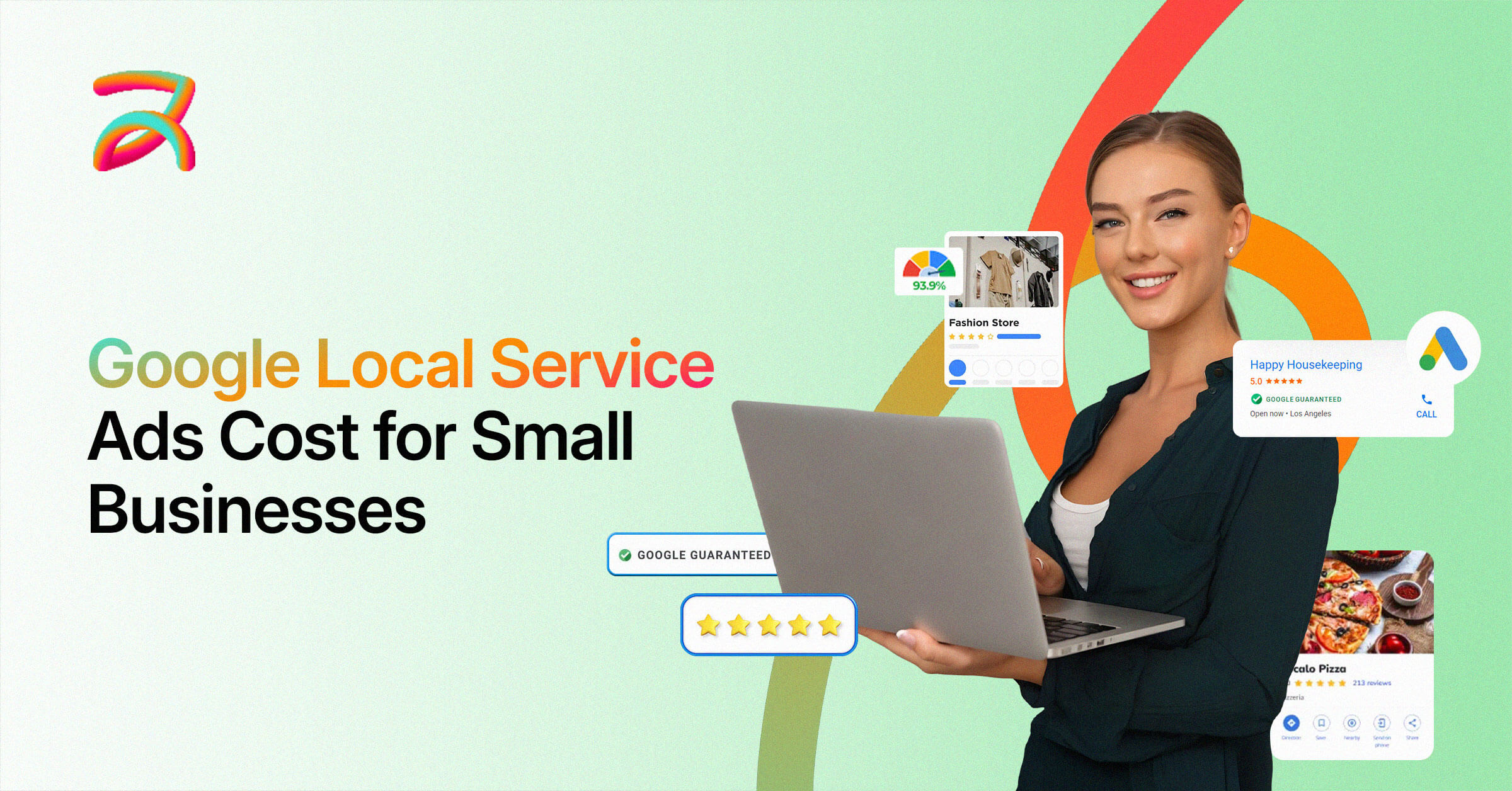Google Local Service Ads cost between $15-$300 per lead, depending on your industry. Most small businesses spend $400-$2,000 monthly for effective results. Unlike traditional social media marketing or standard Google ads, Local Service Ads use a pay-per-lead model that only charges when qualified customers contact your business.
If you’re a service business owner comparing local SEO strategies and digital marketing options, you’ve probably wondered: “How much do local service ads cost, and are they worth it?” The answer isn’t straightforward because LSA pricing varies dramatically by industry, location, and competition levels, but understanding these factors can help you make smarter budget decisions than most Google ads agency recommendations suggest.
Here’s what most small businesses pay: HVAC companies spend $45-75 per lead, plumbers pay $50-85, house cleaning services invest $20-40, while legal services can cost $150-300 per qualified prospect. These numbers seem high compared to social media marketing costs, but LSA leads convert at 15-30% rates versus 2-5% for traditional advertising.
In this comprehensive guide for Local Service Ads, we’ll reveal real-world pricing data from thousands of small businesses, budget allocation strategies that actually work, and optimization techniques that reduce your cost-per-customer while improving lead quality. Whether you’re accessing your Google Local Service Ads login for the first time or looking to scale existing campaigns, this guide provides the data-driven insights you need to succeed.
What Are Google Local Service Ads?
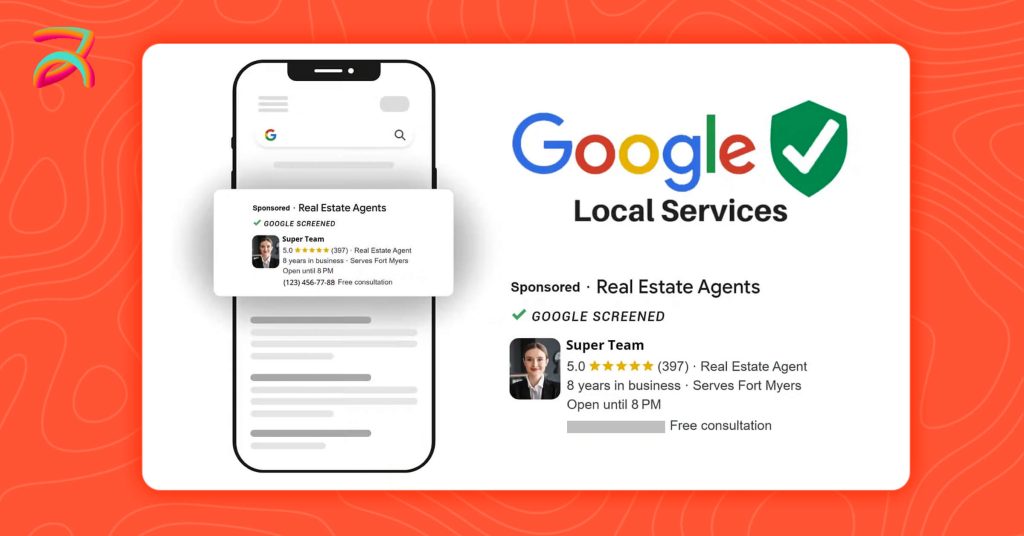
Google Local Service Ads (LSAs) are a premium advertising platform designed specifically for local service providers who want to connect with customers ready to hire. These ads appear at the very top of the search results page, above both organic search results and traditional Google Ads, giving businesses maximum visibility when potential customers search for services in their area.
Definition and Basic Overview
What are local service ads exactly? When someone searches for “plumber near me” or “house cleaning services,” Google LSA ads appear above organic results and regular Google Ads. The visual format includes your business photo, star rating, years in business, and service areas with that coveted “Google Guaranteed” badge.
Here’s what makes them special: these aren’t just regular ads. Google LSA has created a trust-first system where they verify your business credentials, check your licenses, and even run background checks on your team. This verification process means customers see your ad and immediately know you’re legitimate.
The visual appearance is striking, too. Your local service ads show up with a green checkmark, your Google reviews, your service areas, and direct contact information. When potential customers see these ads, they’re not just seeing another advertisement; they’re seeing a Google-endorsed recommendation.
How Google Local Service Ads Work
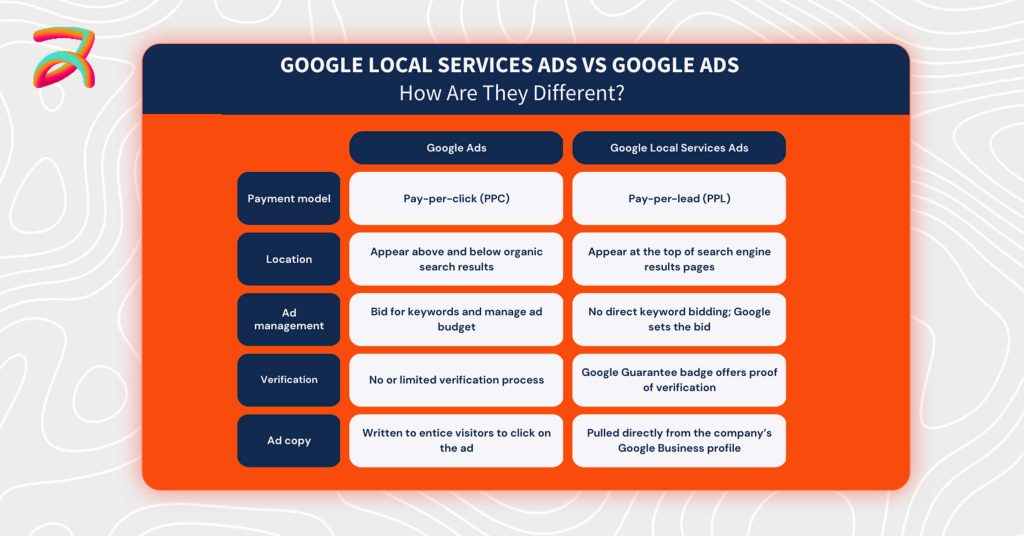
The magic behind LSA Google lies in its lead-based pricing model. Instead of paying every time someone clicks on your ad (like traditional Google Ads), you only pay when you receive a qualified lead. This means every dollar you spend is going toward actual potential customers, not just curious browsers.
The Google Guarantee program is the secret sauce that makes these ads so effective. When customers see that green checkmark and “Google Guaranteed” badge, they know that if they’re not satisfied with your work, Google will reimburse them up to the job value. This guarantee removes the biggest barrier to hiring a new service provider trust.
Local search integration is seamless too. Your local service ads automatically pull information from your Google Business Profile, use your service area settings, and match you with customers based on proximity and availability. It’s like having a smart assistant that only sends you leads when you’re actually able to help.
Google Local Service Ads Cost Breakdown
Understanding Google Local Service Ads cost isn’t as straightforward as traditional advertising pricing, but it’s much simpler once you grasp the basics. Here’s where Google Local Service Ads cost differs from every other digital marketing investment you’ve made. While a comprehensive Google Ads management guide might recommend complex bidding strategies, LSA operates on immediate ROI principles.
Pay-Per-Lead Pricing Model
The local service ads Google pricing system works on a simple principle: you pay only when Google sends you a qualified lead. This could be a phone call that lasts at least 30 seconds, a message through the platform, or a booking request. No clicks, no impressions, no wasted budget on people who aren’t ready to hire.
This is fundamentally different from traditional PPC advertising. With regular Google ads local campaigns, you might pay $5-15 per click, but only 2-3% of those clicks might become customers. With Google LSA, from that same $500 budget, might generate 8-12 leads, with 2-4 of them becoming paying customers.
The lead qualification process is where Google adds value. They screen calls to ensure they’re legitimate business inquiries, filter out spam, and even provide you with dispute resolution if you receive an irrelevant lead. This means the google local service ads cost you pay is for much higher-quality prospects than you’d typically get from other advertising channels.
Average Cost by Industry Categories
Local service ads categories vary significantly in pricing, and understanding your industry’s typical costs is crucial for budget planning. Here’s what small businesses are paying across different service sectors:
| Industry Category | Average Cost Per Lead | Price Range | Typical Conversion Rate |
| HVAC Services | $45-75 | $30-120 | 20-30% |
| Plumbing | $50-85 | $35-130 | 18-28% |
| Electrical | $40-80 | $25-110 | 22-32% |
| Locksmith | $25-50 | $15-75 | 15-25% |
| House Cleaning | $20-40 | $15-60 | 25-35% |
| Handyman | $30-60 | $20-80 | 20-30% |
| Pet Services | $15-35 | $10-50 | 30-40% |
| Legal Services | $150-300 | $100-500 | 10-20% |
| Real Estate | $80-150 | $50-250 | 8-15% |
| Home Security | $60-120 | $40-180 | 12-22% |
These numbers come from analyzing thousands of small business accounts across different markets. When comparing Google Ads vs SEO for small business growth strategies, it’s important to note that your actual Google Local Service Ads cost may vary higher or lower depending on your location and competition.
Factors Affecting Local Service Ads Cost
Your local service ads pricing isn’t set in stone. Several factors influence what you’ll pay, and understanding these can help you optimize your costs:
Geographic location plays a huge role. A plumber in Manhattan will pay significantly more per lead than one in rural Montana. High-competition urban areas with higher average incomes typically see 40-60% higher lead costs than smaller markets.
Competition levels in your area directly impact pricing. If you’re one of three electricians serving a large suburban area, you’ll pay less than if you’re competing with dozens of other electrical contractors. Google LSA login data shows that auction-based pricing means more competition equals higher prices.
Service category demand affects pricing too. Emergency services like locksmith and plumber calls during off-hours typically cost more because customers are willing to pay premium prices for immediate help. Seasonal services see price fluctuations HVAC leads cost more during extreme weather periods.
Lead quality and conversion rates create a feedback loop. If your business consistently converts leads at high rates, Google’s algorithm tends to send you better-quality prospects, which can actually reduce your cost per converted customer over time.
What Is the Recommended Budget for Google Local Services Ads?
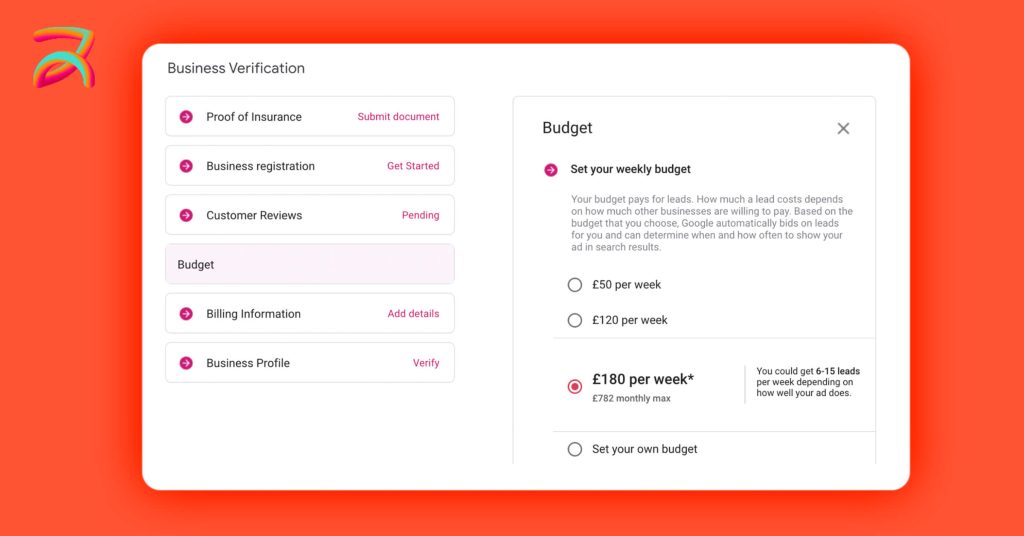
There’s no one-size-fits-all budget, but most small businesses start with $500 to $2,000 per month for Google Local Services Ads (LSAs).
Here’s how to think about your budget:
- Pay-per-lead model: You only pay when a customer contacts you through the ad (not per click).
- Lead costs vary by industry and location. For example:
- Plumbers: $20–$45 per lead
- Lawyers: $50–$150+ per lead
- HVAC / Electricians: $25–$70 per lead
- Google lets you set a weekly budget, and it won’t exceed your max. A good starting point is:
Weekly Budget = Target Leads × Average Cost Per Lead
📌 Example:
If you want 10 leads/week and each lead costs $30, set your weekly budget to $300.
💡 Pro Tip:
Start small, monitor performance, and scale based on ROI. Google’s dashboard helps you see how many leads you’re getting and what they cost.
Budget Planning Strategies
Minimum recommended monthly budget for Local Service Ads should be at least 10-15 times your average cost per lead. This gives you enough volume to see meaningful results and allows the algorithm to optimize your lead quality over time. For most service businesses, this translates to $400-800 minimum monthly spend.
Budget allocation by business size follows a general pattern. Newer businesses should start conservatively with 15-20% of their total marketing budget dedicated to local service ads, while established businesses with proven conversion systems can allocate 30-50% of their digital marketing spend to LSA.
ROI-based budget setting is the most effective approach. Calculate your average customer lifetime value, multiply by your LSA conversion rate, then subtract your cost per lead. This gives you your profit per lead, which should guide your maximum comfortable spend level.
Budget Examples by Business Type
Startup service businesses ($300-800/month): If you’re just getting started, focus on consistency over volume. A $500 monthly budget in most markets will generate 8-15 leads, giving you enough data to optimize while keeping costs manageable. This budget works well for solo operators or small teams just building their customer base.
Established small businesses ($800-2000/month): Once you have proven systems for converting leads and delivering services, scaling up to $1000-1500 monthly often provides the sweet spot for ROI. This typically generates 20-40 leads per month, allowing for seasonal fluctuations while maintaining steady growth.
Growing medium businesses ($2000-5000/month): Larger operations with multiple service areas or team members can benefit from higher budgets. At this level, you’re looking at 50-100+ leads monthly, which requires solid lead management systems but can drive significant revenue growth.
Budget Optimization Tips
Seasonal budget adjustments can dramatically improve your ROI. HVAC companies should increase budgets during summer and winter peaks, while landscaping services should focus spending on spring months. Track your industry’s seasonal patterns and adjust accordingly.
Performance-based scaling means increasing budgets only when conversion rates justify the investment. If you’re converting 25% of leads profitably, gradually increase spend. If conversion drops below 15%, pause and optimize your sales process before scaling.
Cost control mechanisms in Google Local Service Ads include setting weekly spending limits, pausing ads during busy periods, and using the “snooze” feature when you’re at capacity. These tools help prevent budget overruns while maintaining lead flow consistency.
📍 Ready to Start with Local Service Ads?
Begin by completing your Google Business Profile and gathering your verification documents it’s your first step to showing up for local customers.
Start Setup Now →Google Local Service Ads vs Google Ads: Cost Comparison
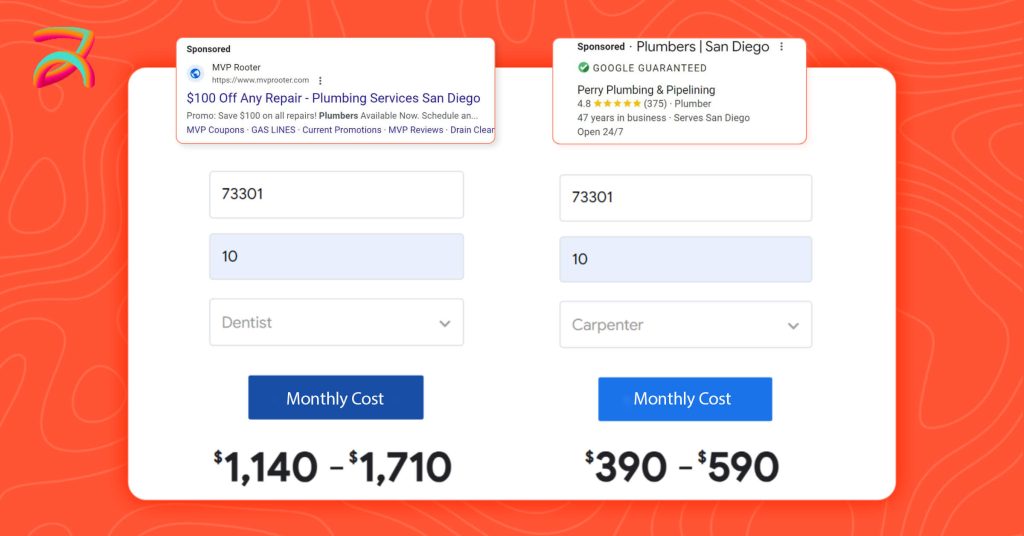
The google ads vs local service ads debate comes up constantly in small business circles, and for good reason. Both platforms can drive customers, but their cost structures and effectiveness vary dramatically depending on your business type and goals.
Pricing Model Differences
The fundamental difference between local service ads and traditional Google Ads lies in what you’re paying for. Google ads local campaigns charge you per click, regardless of whether that click becomes a customer. You might pay $3-15 every time someone visits your website, even if they immediately leave or never contact you.
Pay-per-lead vs pay-per-click creates completely different economics. With Local Service Ads, you’re essentially buying qualified prospects instead of website traffic. A lead costs more upfront ($30-75 typically), but these are people who have already indicated serious interest in hiring someone for your service.
Quality vs quantity of leads is where the real difference emerges. Traditional Google Ads might generate 100 website visits from a $500 budget, but only 2-3 of those visitors might actually contact you. Lsa google from that same $500 budget might generate 8-12 leads, with 2-4 of them becoming paying customers.
ROI Comparison Analysis
Let’s break down the real numbers with a practical example. Here’s what $1000 in monthly ad spend typically generates for a plumbing business:
| Metric | Local Service Ads | Traditional Google Ads |
| Monthly Budget | $1,000 | $1,000 |
| Cost Per Lead/Click | $60 (per lead) | $8 (per click) |
| Total Leads/Clicks | 17 leads | 125 clicks |
| Conversion Rate | 22% | 4% |
| New Customers | 4 customers | 5 customers |
| Average Job Value | $350 | $350 |
| Total Revenue | $1,400 | $1,750 |
| Customer Acquisition Cost | $250 | $200 |
| Trust Factor | Google Guarantee | Ad credibility varies |
While traditional Google Ads edge out slightly in this example for total customers acquired, Local Service Ads offer several advantages: higher-intent leads, Google Guarantee credibility, and less management time required.
The conversion rate implications are significant too. Google lsa data shows that Local Service Ads leads are pre-qualified by Google and are actively looking to hire someone immediately. Google Ads traffic might include people researching, comparing prices, or looking for DIY solutions.
How to Optimize Google Local Service Ads for Better Cost Efficiency
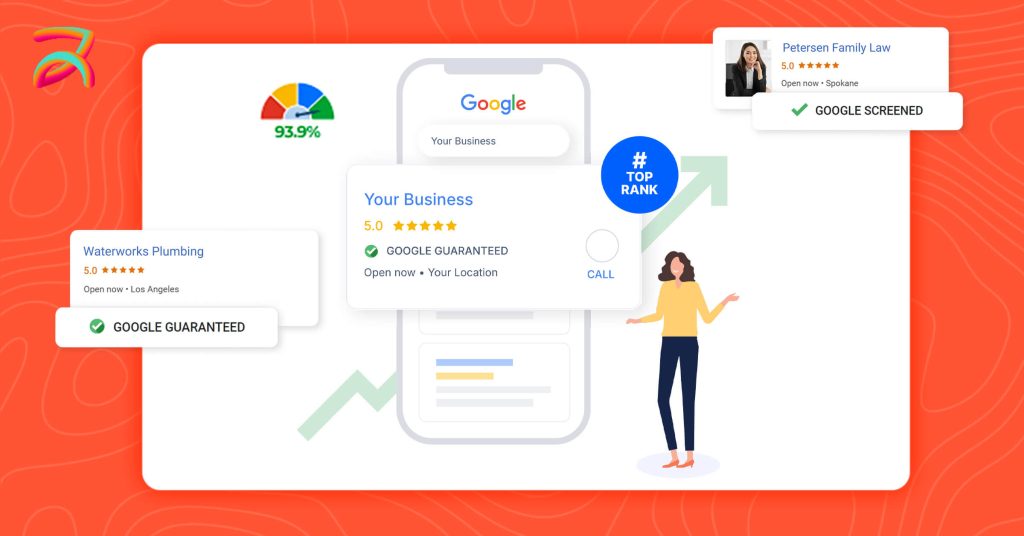
Getting the most value from your google local service ads cost requires ongoing optimization and attention to detail. Unlike social media marketing campaigns that focus on audience targeting and creative testing, LSA success depends primarily on operational excellence and customer service quality.
Profile Optimization Strategies
Complete business profile setup is your foundation for cost efficiency. Google rewards businesses with complete, accurate profiles by sending them higher-quality leads. This means filling out every section: business hours, service areas, service types, photos, and detailed business descriptions.
Review management importance cannot be overstated for local service ads. Your Google reviews directly impact how often your ad appears and the quality of leads you receive. Businesses with 4.5+ star ratings typically see 25-40% better lead quality and conversion rates compared to those with lower ratings. Actively request reviews from satisfied customers and respond professionally to all feedback.
Service area optimization affects both lead quality and cost. Being too broad with your service area results in leads from locations you don’t want to serve, while being too narrow limits your potential. The sweet spot is typically a 30-45 minute drive radius from your base location, adjusted for traffic patterns and profitability.
Lead Management Best Practices
Quick response time importance directly impacts your ROI from local service ads. Google tracks how quickly you respond to leads, and businesses that answer within 2-3 minutes convert 40-60% more leads than those who wait even 10-15 minutes. Set up call forwarding, use automated text responses, or designate someone specifically for lead follow-up.
Lead qualification techniques help you avoid wasting time on poor-fit prospects. Develop a quick 3-4 question screening process to determine if a lead matches your ideal customer profile. Questions about timeline, budget range, and specific needs help you prioritize your best opportunities.
Follow-up strategies maximize conversion from every lead you pay for. Create a systematic approach: immediate response, follow-up within 24 hours if no initial contact, and a final follow-up within 72 hours. Many businesses lose potential customers simply because they give up after one attempt.
Performance Monitoring
Key metrics to track for local service ads include lead volume, conversion rate, cost per converted customer, and average job value. Most successful businesses review these weekly and make adjustments monthly. Track patterns do certain days generate better leads? Are specific service types more profitable?
Cost optimization techniques include disputing irrelevant leads (Google will credit your account), adjusting your service offerings based on profitability, and pausing ads during periods when you can’t provide good service. Many businesses forget they can dispute leads that don’t meet Google’s qualification standards.
When to adjust budgets depends on capacity and performance trends. Increase budgets when you’re converting 20%+ of leads profitably and have capacity for more work. Decrease when conversion rates drop below 15% or when you’re consistently booked weeks in advance.
Local Service Ads Login and Management
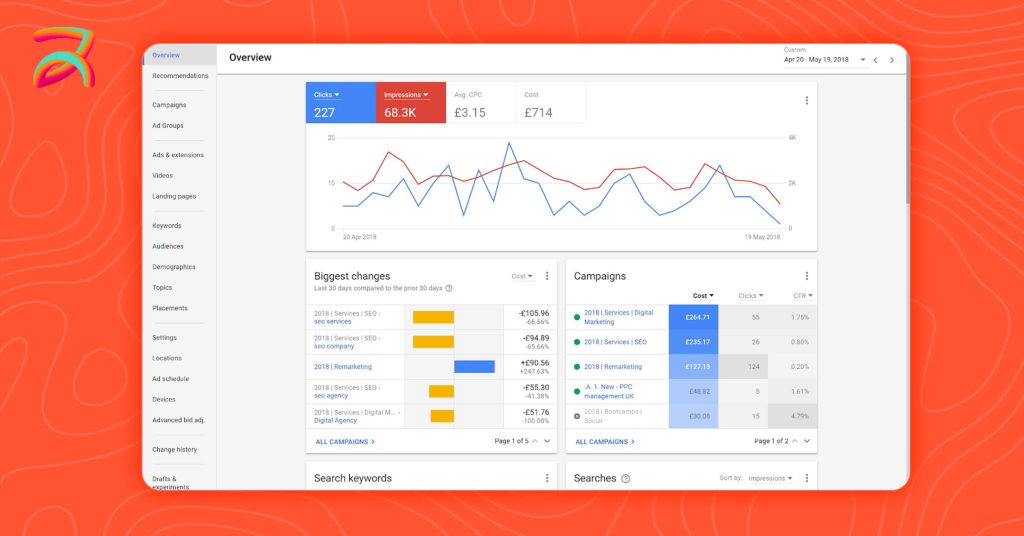
Managing your local service ads effectively starts with understanding the platform and setting up efficient workflows. Many small business owners struggle with the technical aspects, but mastering the basics can significantly improve your results and reduce your stress.
Getting Started with Google Local Service Ads Login
Account setup process begins with your Google Local Service Ads login, which connects to your existing Google account. You can also access through google lsa login. You’ll need to verify your business through Google My Business first, then complete the Local Service Ads application process. This includes license verification, background checks for relevant industries, and insurance confirmation.
Verification requirements vary by industry but typically include business registration, relevant licenses, insurance certificates, and background checks for businesses that work in customers’ homes. The process usually takes 5-10 business days, but complex businesses or those in highly regulated industries might wait 2-3 weeks.
Dashboard navigation becomes intuitive once you understand the main sections. The “Leads” tab shows all incoming prospects, “Budget” manages your spending controls, “Profile” lets you update business information, and “Performance” provides analytics. Spend time learning these sections efficient navigation saves hours weekly.
Managing Your Local Service Ads Account
Daily management tasks should include checking new leads (respond within minutes), reviewing yesterday’s performance, and adjusting budgets if needed. Most successful businesses spend 10-15 minutes daily on Google LSA management, focusing on lead response and basic monitoring.
Budget control features include weekly budget caps, pause/resume functions, and automatic notifications when you’re approaching limits. Set up text or email alerts for new leads and budget warnings. Many businesses miss opportunities because they don’t have proper notification systems.
Performance reporting provides insights for optimization. Weekly reports should focus on lead volume, lead quality, and conversion tracking. Monthly reports should analyze trends, seasonal patterns, and ROI calculations. Use this data to make informed decisions about budget allocation and service focus.
Pros and Cons of Google Local Service Ads
Every marketing channel has trade-offs, and Google Local Service Ads are no exception. Understanding both the advantages and limitations helps you set realistic expectations and make informed decisions about your advertising strategy.
| Advantages | Disadvantages |
| Pay only for qualified leads – Every dollar goes toward actual prospects who contacted you about your services | Limited to specific service categories – Many legitimate service businesses can’t access LSA due to category restrictions |
| Google Guarantee builds trust – The verification badge eliminates customer hesitation about hiring unknown providers | Strict verification requirements – Background checks, license verification, and insurance confirmation take weeks |
| Prime placement in local search – LSA appears above organic results and traditional ads for maximum visibility | Less control over targeting – Can’t target specific demographics, interests, or detailed location parameters |
| Higher conversion rates than traditional ads – 15-30% vs 2-5% for traditional ads due to pre-qualified prospects | Higher cost per interaction – $30-75 per lead vs $3-8 per click requires different budget planning |
| No keyword bidding complexity – Google handles targeting complexity, reducing management time significantly | Limited creative control – All ads look similar with differentiation mainly through reviews and photos |
| Mobile-optimized for local searches – Perfect for on-the-go service searches when customers need immediate help | Geographic restrictions – Separate verification needed for multiple markets, complex for wide service areas |
| Direct customer contact information – Eliminates website friction with immediate phone calls and messaging | Potential for irrelevant leads – Despite qualification efforts, some leads may not match your service offerings |
Local Service Ads Agency vs DIY Management
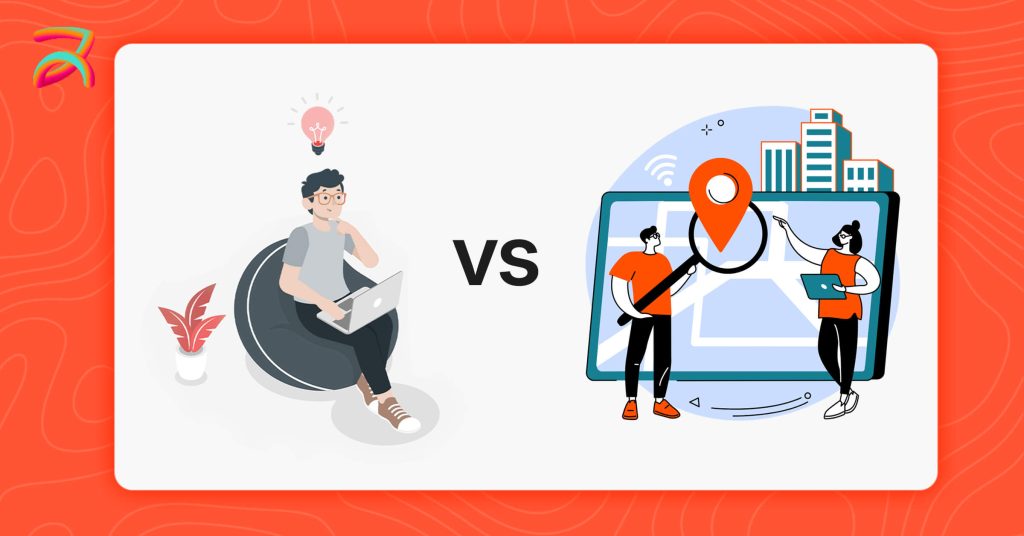
Deciding whether to manage local service ads yourself or hire a local service ads agency depends on your business size, technical comfort level, and available time. Both approaches can work, but the right choice varies based on your specific situation.
When to Consider Professional Management
Complexity of multi-location businesses often justifies professional management. If you operate in multiple cities or have several service locations, coordinating verification, managing separate budgets, and optimizing performance across locations becomes time-consuming. Agencies have systems for managing complex account structures efficiently.
Time constraints for business owners represent the most common reason for seeking help. Managing local service ads effectively requires daily attention to leads, weekly performance review, and monthly optimization. If you’re already working 60+ hour weeks running your business, adding LSA management might impact service quality or personal time.
Advanced optimization needs emerge as businesses scale. Larger operations benefit from sophisticated lead scoring, advanced analytics, integration with CRM systems, and coordination with other marketing channels. Agencies often have tools and expertise that individual businesses can’t justify purchasing.
Cost-Benefit Analysis
Agency fees vs improved performance require careful calculation. Most local service ads agency providers charge 15-25% of ad spend plus setup fees. However, good agencies often improve lead quality and conversion rates enough to offset their fees. A 20% improvement in conversion rates typically justifies a 20% management fee.
DIY management pros and cons vary by business owner. Pros include complete control, no agency fees, and intimate knowledge of your business needs. Cons include time investment, learning curve, and potential for costly mistakes during the optimization process.
Hybrid approach options work well for many businesses. Start by managing local service ads yourself for 3-6 months to understand the platform and your results. Then consider hiring help for specific aspects like lead management, performance optimization, or expansion to new markets.
The decision often comes down to opportunity cost. If spending 10 hours weekly on LSA management prevents you from serving customers or growing other aspects of your business, professional management might provide better overall ROI.
Consider your capacity for quick lead response before deciding between agency management and DIY approaches. Test self-management first if you have reliable systems for handling prospects.
Struggling to show up when customers search for your service?
Local Service Ads can put your business at the top of Google, literally. We’ll handle the setup, so you can focus on what you do best.
Book Your Free Consultation Today →Local Search Ads Future Trends and Predictions
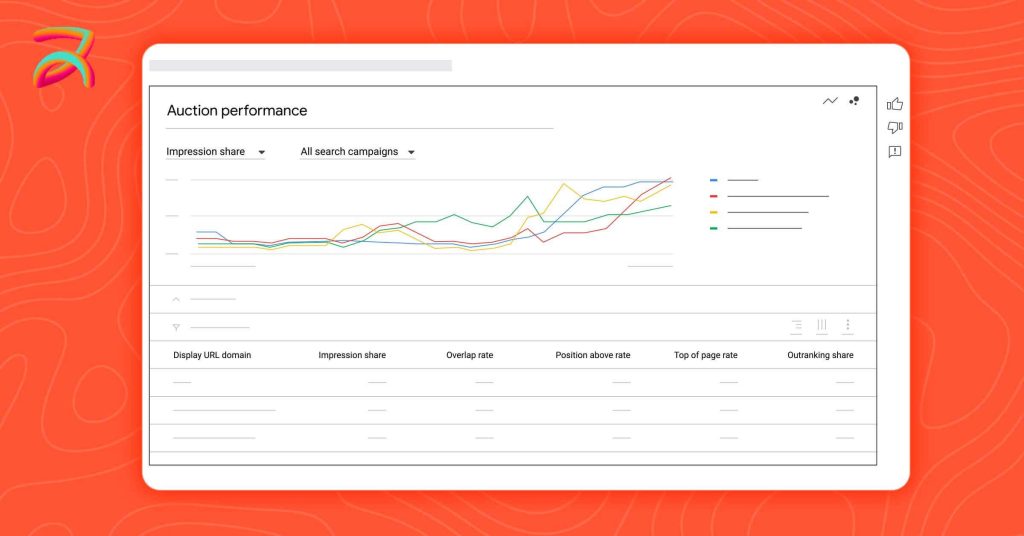
Local search ads continues evolving rapidly, with Google introducing new features and expanding opportunities for service businesses. Understanding these trends helps you prepare for changes and capitalize on new opportunities.
Industry Evolution
Expanding service categories represents the most visible trend in local service ads. Google consistently adds new business types, recently including pet services, event planning, and various professional services. This expansion means more businesses can access LSA benefits, but it also increases competition in established categories.
Integration with Google Business Profile is becoming more seamless, with LSA pulling more information from your business profile and reviews. This integration means maintaining an optimized Google Business Profile becomes even more critical for LSA success. Businesses with incomplete or outdated profiles will face increasing disadvantages.
AI-powered lead matching is improving lead quality through better understanding of customer intent and business capabilities. Google’s machine learning algorithms are getting better at matching customer needs with appropriate service providers, potentially reducing irrelevant leads while improving conversion rates for qualified prospects.
Cost Predictions for 2025-2026
Expected pricing trends suggest continued gradual increases in google local service ads cost, particularly in competitive markets. However, this increase should be offset by improved lead quality and better targeting accuracy. Businesses should budget for 5-10% annual cost increases while expecting better ROI from higher-quality leads.
Market competition impact will vary by industry and location. Established categories like HVAC and plumbing will see continued price pressure as more businesses join the platform. Newer categories might see more stable pricing as Google works to attract participants and build market share.
New features affecting costs could include enhanced targeting options, premium placement tiers, and integration with other Google advertising products. These features might create opportunities for businesses willing to invest in advanced capabilities while maintaining cost-effective options for smaller operators.
The overall trend suggests local service ads will become more sophisticated and effective over time, justifying higher costs through better results. Businesses that invest in understanding and optimizing their LSA presence now will be better positioned for future changes.
Frequently Asked Questions
Monthly Google Local Service Ads cost varies significantly based on your industry, location, and lead volume goals. Most small service businesses spend $400-1,500 monthly, while larger operations might invest $2,000-5,000. The key is starting with a budget that allows 10-15 leads per month in your market. This provides enough data to optimize while keeping costs manageable.
Google ads vs local service ads pricing models are fundamentally different. Google Ads charges per click ($2-15 typically), regardless of whether clicks become customers. Local Service Ads charge per qualified lead ($20-150 depending on industry), meaning you only pay when someone actually contacts you about hiring your services. While LSA costs more per interaction, the leads are higher quality and convert at 15-30% rates compared to 2-5% for traditional Google Ads.
Yes, you can set weekly budget limits in your Google Local Service Ads login dashboard. While there’s no daily budget option, the weekly budget cap helps control spending. You can also pause ads anytime, use the “snooze” feature when you’re at capacity, and adjust budgets based on your availability and cash flow needs.
Local service ads charge for qualified leads, not conversions. You pay when someone contacts you with legitimate interest in your services, regardless of whether they ultimately hire you. However, you can dispute leads that don’t meet Google’s qualification standards like wrong service requests, spam calls, or calls under 30 seconds. Google typically credits disputed leads within 5-7 business days.
Reducing google local service ads cost while maintaining results requires optimization across several areas. Improve your response time to under 3 minutes, optimize your business profile completely, focus on service areas where you’re most profitable, dispute irrelevant leads promptly, and adjust budgets based on your conversion patterns. Businesses with 4.5+ star ratings typically receive better quality leads at lower costs.
Requirements for local service ads include business license verification, appropriate insurance coverage, background checks for applicable industries, and Google My Business profile completion. Specific requirements vary by industry home service providers need background checks, while professional services might need additional credential verification. The process typically takes 5-14 business days for approval.
Access Google Local Service Ads login through ads.google.com using your existing Google account, then navigate to the Local Services section. Alternatively, visit localservices.google.com directly or use google lsa login search terms to find the platform. You’ll need to complete verification before accessing the full dashboard, but you can start the application process immediately after login.
Local service ads categories currently include HVAC, plumbing, electrical, locksmith, house cleaning, handyman, landscaping, pest control, appliance repair, garage door services, flooring, painting, roofing, tree services, pet services, legal services, real estate, home security, moving services, and several others. Google continues expanding categories regularly, so check the current list if your industry wasn’t mentioned.
LSA approval typically takes 5-10 business days for straightforward applications. Complex businesses, those requiring extensive background checks, or applications with incomplete documentation might take 2-3 weeks. License verification and insurance confirmation are usually the longest steps in the process.
Yes, you can pause local service ads instantly through your dashboard. Use the “snooze” feature for temporary pauses (great when you’re at capacity), or fully pause ads for longer breaks. You can also adjust your availability schedule, modify service areas, or reduce budgets instead of complete pausing if you want to maintain some lead flow.
Conclusion and Action Steps
Understanding Google Local Service Ads cost is just the beginning success comes from implementing a strategic approach that aligns with your business goals and capabilities. Throughout this guide, we’ve covered real-world pricing data, optimization strategies, and practical insights from businesses actually using local service ads to grow their operations.
Key Takeaways Summary
Cost expectations for different business sizes should guide your initial budget planning. Small businesses typically invest $400-800 monthly to start, while established operations often scale to $1,500-3,000 monthly as they prove ROI. Remember, you’re buying qualified leads, not just advertising exposure this changes how you should evaluate costs and returns.
ROI potential assessment shows that businesses converting 20%+ of their LSA leads typically achieve 50-100% return on investment. The key factors for success include quick response times, complete profile optimization, systematic follow-up processes, and pricing strategies that account for lead acquisition costs. Your conversion rate matters more than your cost per lead.
Decision-making framework should consider your current lead generation success, available time for management, and ability to respond quickly to prospects. Local service ads work best for businesses with established service delivery systems and sales processes. If you’re struggling with basic business operations, fix those issues before investing heavily in LSA.


